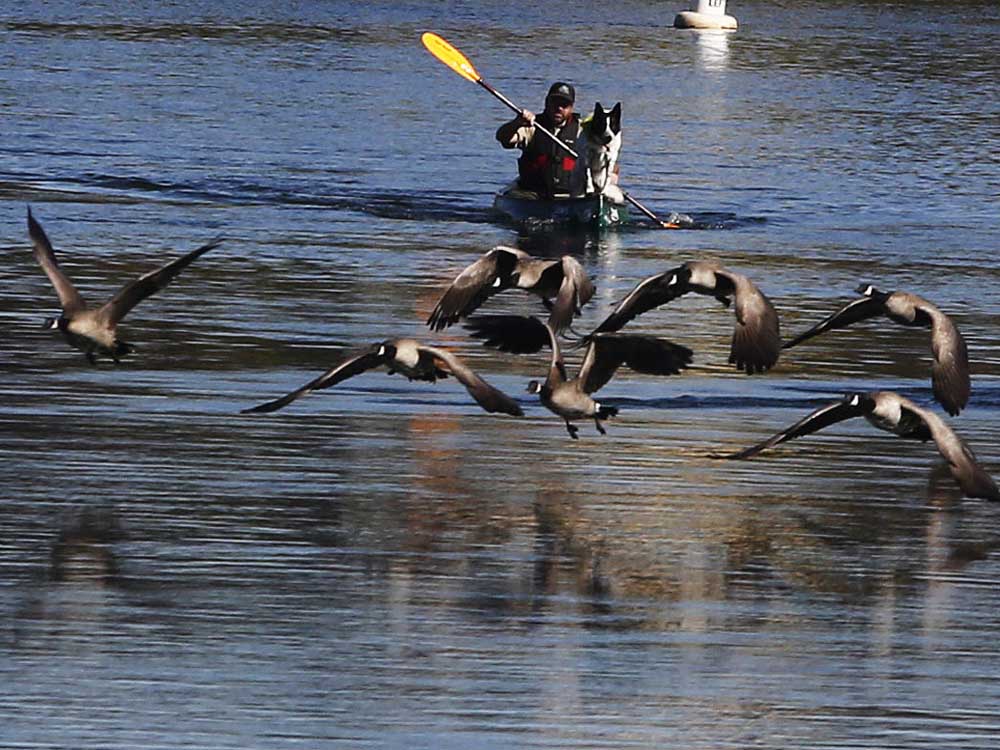Goose chase still going strong in Bend parks
Published 12:00 am Tuesday, September 20, 2016

- Jarod Opperman / The BulletinBend Park & Recreation District employee Jason Scarberry scares off geese with his dog, Willie, from the Deschutes River near the Old Mill in Bend on Friday.
Eight years into a campaign to push Canada geese out of Bend parks, their numbers have been cut substantially.
Jeff Amaral, who supervises the Bend Park & Recreation District’s anti-goose efforts, said at the beginning, surveys found between 500 and 700 Canada geese chomping on grass in the city’s riverfront parks at any one time. These days, surveys peg their numbers between 50 and 150, he said.
The grass and pathways at Drake Park and other riverfront parks are no longer as thickly caked with goose excrement as they once were. Although city geese don’t typically migrate with the seasons, some have left, Amaral said, with hunters killing banded Bend park geese in California and Washington. Others have decamped to nearby golf courses, or the canals winding through the east side of town.
Amaral said the current goose numbers are considered manageable, measured more by the damage they do to park properties than a head count. But the effort to keep the population in check continues, with district employees and volunteers engaged in regularly disrupting or “hazing” the geese, and hunting down nests to oil their eggs.
Egg oiling involves finding recently laid goose eggs and rubbing them with a layer of vegetable oil. The oil clogs the porous shell of the egg and suffocates the unborn gosling, but the parent geese will continue to care for the egg through the hatching season.
If the eggs were instead removed or destroyed, the geese would lay and tend to a new egg.
Amaral said egg-oiling efforts began on park district property, but have since expanded with the permission of property owners to locating nests on adjoining land. He said mating pairs will often return to the same site year after year — or a new pair will take over a particularly attractive site — and those sites have been catalogued and are revisited every time egg oiling ramps up in spring.
“The number of eggs oiled has steadily increased since about 2009, and I don’t think that’s happening because there’s more geese or more nests, I think we’re still learning the goose locations,” Amaral said.
Those eggs that elude the egg oilers hatch into goslings, some of which are removed. The district relocates between 40 and 60 juvenile geese each year, Amaral said, trucking the birds to Summer Lake in cooperation with the Oregon Department of Fish & Wildlife.
In 2010, the district killed more than 100 adult geese, forcing the birds into garbage cans and gassing them with carbon dioxide. The move sparked a backlash, and even a candlelight vigil held at Drake Park.
Before that, the district fed female geese food laced with a birth control drug. Amaral said though the drug was effective, hand-feeding it to the geese every day during nesting season was impractical, and incompatible with hazing efforts.
Park district employee Jason Scarberry and his dog, Willie, handle the district’s goose-hazing duties.
Scarberry said he and Willie spend 8 to 12 hours a week chasing geese in Bend’s riverfront parks, sometimes on land, and sometimes in Scarberry’s canoe.
Willie was training for his goose-chasing gig well before it existed. Scarberry said when Willie was a pup, they’d often stop by Drake Park early in the morning. Willie took an immediate interest in the geese.
“They were so much bigger than him, they just kind of raised themselves up and looked at him and gave him a giggle,” Scarberry said. “So I’d be like, ‘You and me buddy, let’s chase ’em together.’ I never thought I’d be doing this for a living, it just kind of happened.”
Scarberry said the goal of his hazing is twofold — encourage geese that might be willing to find a new home to do so, and discourage the rest from lingering on the grass.
A less obvious effort to diminish the goose population goes on in the park district’s design department. Riverfront parks built or renovated in recent years have a wider buffer zone of native plants in the riparian area where water meets land, making it a little more difficult for a goose to waddle onshore for a meal.
“Geese, like all animals, need to conserve energy,” Amaral said. “If they can just walk up the beach to eat turf, they’ll do that,” he said.
— Reporter: 541-383-0387, shammers@bendbulletin.com






